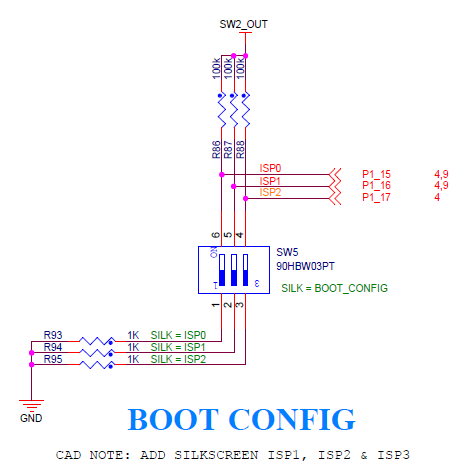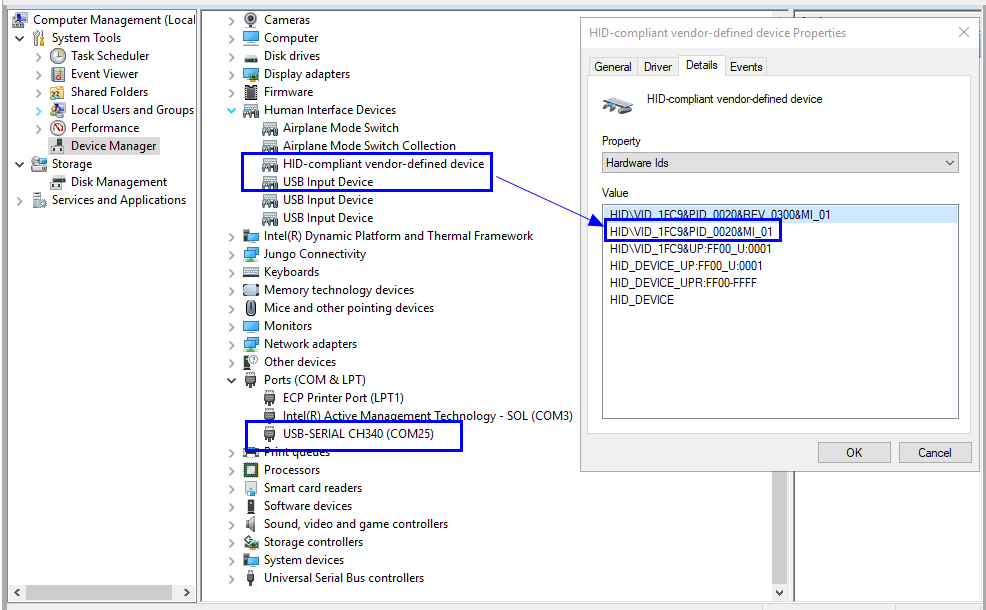大家好,我是痞子衡,是正经搞技术的痞子。今天痞子衡给大家介绍的是恩智浦i.MX RTxxx系列MCU的Serial ISP模式。
在上一篇文章 Boot配置(ISP Pin, OTP) 里痞子衡为大家介绍了i.MXRTxxx Boot的行为配置,其中第1.2节里讲了Boot有三类行为模式:Serial ISP、Serial Boot、Device Boot,后两种都是跟App启动执行相关的行为模式,而Serial ISP模式则是相对独立的Flash下载功能,有了Serial ISP,便可省去专用Flash编程器,今天痞子衡就来详细聊一聊Serial ISP模式。
痞子衡在前面已经讲过Serial ISP模式是一种串行编程模式,在这种模式下,BootROM通过指定的UART/SPI/I2C/USB-HID口来接收来自Host(恩智浦提供了上位机工具blhost.exe或者MCUBootUtility)的Application数据,并将数据下载进i.MXRTxxx支持的所有外部非易失性存储器中,为后续从外部存储器启动做准备。
一、进入Serial ISP模式
i.MXRTxxx上电永远是从ROM启动去执行BootROM程序,最顶层的Boot行为模式由OTP memory里的PRIMARY_BOOT_SRC[3:0]位和芯片外部ISP[2:0]管脚状态共同决定。假设我们正处于研发阶段,PRIMARY_BOOT_SRC[3:0]并未烧写,那想进入Serial ISP模式最直接的方式便是将ISP[2:0]输入状态拨成3'b110,在设计i.MXRTxxx的硬件板时ISP[2:0] pins应设计成可通过拨码开关选择输入电平,下图是RT600-EVK板(Rev.E)的参考设计:

拨码开关SW5应拨向SW_DIP-6的6,即设置ISP[2:0]=3'b110,此时便直接进入了Serial ISP模式。
二、blhost的使用
进入了Serial ISP模式,此时便可以用恩智浦提供的host工具与BootROM进行命令交互,host工具在 MCUBootUtility包 里。下载好MCUBootUtility包之后,在\MCUBootUtility\Tools\blhost2_3\win下可以找到用于与BootROM通信的blhost.exe。
2.1 支持的通信外设pinout
BootROM支持四种通信外设,分别是UART/SPI/I2C/USB-HID(其中UART和USB比较常用),pinout如下(Pinout适用RT600):

2.2 blhost用法
blhost.exe是命令行工具,使用blhost可以通过上述UART/SPI/I2C/USB-HID口与BootROM进行通信与命令交互。
在命令行下打开blhost.exe,输入-?命令可以看到blhost使用帮助,blhost支持的命令很多:
PS D:\NXP-MCUBootUtility\tools\blhost2_3\win> .\blhost.exe
usage: D:\NXP-MCUBootUtility\tools\blhost2_3\win\blhost.exe
[-?|--help]
[-p|--port <name>[,<speed>]]
[-u|--usb [[[<vid>,]<pid>]]]
[-t|--timeout <ms>]
-- command <args...>
Options:
-?/--help Show this help
-p/--port <name>[,<speed>] Connect to target over UART. Specify COM port
and optionally baud rate
(default=57600)
If -ftbi, then port is BusPal port
--ftdi spi[,<speed>,<polarity>,<phase>,lsb|msb] |
i2c[,<address>,<speed>]
Use SPI or I2C for BusPal<-->Target link
All parameters between square brackets are
optional, but preceding parameters must be
present or marked with a comma.
(ex. -b spi,1000,0,1) (ex. --ftdi spi,1000,,lsb)
spi: speed(KHz),
polarity(0=active_high | 1=active_low),
phase(0=rising_edge | 1=falling_edge),
"lsb" | "msb"
(default=100,1,1,msb)
i2c: address(7-bit hex), speed(KHz)
(default=0x10,100)
-u/--usb [[[<vid>,]<pid>] | [<path>]]
Connect to target over USB HID device denoted by
vid/pid (default=0x15a2,0x0073) or device path
-t/--timeout <ms> Set packet timeout in milliseconds
(default=5000)
Memory ID:
Internal Memory Device internal memory space
0 Internal Memory
(Default selected memory)
16 (0x10) Execute-only region on internal flash
(Only used for flash-erase-all)
Mapped External Memory The memories that are remapped to internal space,
and must be accessed by internal addresses.
(IDs in this group are only used for flash-erase-all and
configure-memory, and ignored by write-memory, read-memory,
flash-erase-region and flash-image(use default 0))
1 QuadSPI Memory
9 FlexSPI nor Memory
Unmapped External Memory Memories which cannot be remapped to internal space,
and only can be accessed by memories' addresses.
(Must be specified for all commands with <memoryId> argument)
272 (0x110) SPI nor/EEPROM Memory
288 (0x120) uSDHC SD Memory
289 (0x121) uSDHC MMC Memory
** Note that not all memories are supported on all platforms.
Command:
reset Reset the chip
get-property <tag> [<memoryId> | <index>]
Return bootloader specific property.
<memoryId> and <index> are required by some properties.
<memoryId> = 0, <index> = 0, if not specified.
<memoryId> and <index> are ignored for the other properties.
If <index> is over the range supported by the device, bootloader
will treat as <index> = 0.
1 Bootloader version
2 Available peripherals
3 Start of program flash, <index> is required
4 Size of program flash, <index> is required
5 Size of flash sector, <index> is required
6 Blocks in flash array, <index> is required
7 Available commands
9 Last Error
10 Verify Writes flag
11 Max supported packet size
14 Start of RAM, <index> is required
15 Size of RAM, <index> is required
23 QuadSpi initialization status
24 Target version
25 External memory attrubutes, <memoryId> is required
27 Flash page size, <index> is required
28 Interrupt notifier pin
29 FFR key store update option
set-property <tag> <value>
10 Verify Writes flag
28 Interrupt notifier pin
<value>:
bit[31] for enablement, 0: disable, 1: enable
bit[7:0] for GPIO pin index
bit[15:8] for GPIO port index
29 FFR key store update option
<value>:
0 for Keyprovisioning
1 for write-memory
flash-erase-region <addr> <byte_count> [memory_id]
Erase a region of flash according to [memory_id].
flash-erase-all [memory_id] Erase all flash according to [memory_id],
excluding protected regions.
read-memory <addr> <byte_count> [<file>] [memory_id]
Read memory according to [memory_id] and write to file
or stdout if no file specified
write-memory <addr> [<file>[,byte_count]| {{<hex-data>}}] [memory_id]
Write memory according to [memory_id] from file
or string of hex values,
e.g. data.bin (writes entire file)
e.g. data.bin 8 (writes first 8 bytes from file)
e.g. "{{11 22 33 44}}" (w/quotes)
e.g. {{11223344}} (no spaces)
fill-memory <addr> <byte_count> <pattern> [word | short | byte]
Fill memory with pattern; size is
word (default), short or byte
receive-sb-file <file> Receive SB file
execute <addr> <arg> <stackpointer>
Execute at address with arg and stack pointer
call <addr> <arg> Call address with arg
configure-memory <memory_id> <internal_addr>
Apply configuration block at internal memory address
<internal_addr> to memory with ID <memory_id>
key-provisioning <operation> [arguments...]
<enroll>
Key provisioning enroll. No argument for this operation
<set_user_key> <type> <file>[,<size>]
Send the user key specified by <type> to bootloader. <file> is
the binary file containing user key plaintext. If <size> is not
specified, the entire <file> will be sent. Otherwise, only send
the first <size> bytes
<set_key> <type> <size>
Generate <size> bytes of the key specified by <type>
<write_key_nonvolatile> [memoryID]
Write the key to a nonvolatile memory
<read_key_nonvolatile> [memoryID]
Load the key from a nonvolatile memory to bootloader
<write_key_store> <file>[,<size>]
Send the key store to bootloader. <file> is the binary file
containing key store. If <size> is not specified, the entire
<file> will be sent. Otherwise, only send the first <size> bytes
<read_key_store> <file>
Read the key store from bootloader to host(PC). <file> is the
binary file to store the key store
flash-image <file> [erase] [memory_id]
Write a formated image <file> to memory with ID
<memory_id>. Supported file types: SRecord
(.srec and .s19) and HEX (.hex). Flash is erased
before writing if [erase]=erase. The erase unit
size depends on the target and the minimum erase
unit size is 1K.
list-memory List all on-chip Flash and RAM regions, and off-chip
memories, supported by current device.
Only the configured off-chip memory will be list.
efuse-program-once <addr> <data> [nolock/lock]
Program one word of OCOTP Field
<addr> is ADDR of OTP word, not the shadowed memory address.
<data> is hex digits without prefix '0x'
efuse-read-once <addr>
Read one word of OCOTP Field
<addr> is ADDR of OTP word, not the shadowed memory address.
generate-key-blob <dek_file> <blob_file>
Generate the Blob for given Dek Key
<dek_file> - input, a binary Dek Key (128 Bits) generated by CST tool.
<blob_file> - output, a generated blob (72 Bytes) in binary format.
** Note that not all commands/properties are supported on all platforms.当使用串口转USB模块连接i.MXRTxxx的Flexcomm UART0或者使用USB Cable连接上USB1口后可以看到PC设备管理器会识别出相关设备:

让我们尝试一下使用blhost与BootROM通信,先试一下USB通信:
PS D:\NXP-MCUBootUtility\tools\blhost2_3\win> .\blhost.exe -u 0x1fc9,0x0020 -- get-property 1
Inject command 'get-property' Response status = 0 (0x0) Success. Response word 1 = 1258487808 (0x4b030000) Current Version = K3.0.0
再接着试一下UART通信,似乎通信失败了。需要注意的是,当使用USB通信过一次之后,BootROM已经激活USB外设,不会再去检测其他外设(包括UART),如果想使用UART通信,需要将板子reset一次,使BootROM重回外设检测状态。
PS D:\NXP-MCUBootUtility\tools\blhost2_3\win> .\blhost.exe -p COM25 -- get-property 1
Error: Initial ping failure: No response received for ping command.
三、下载更新Application示例
因为BootROM支持启动的外部存储器很多,所以Serial ISP模式下进行Application更新操作要指定具体的外部存储器类型。在上一节blhost的命令帮助里,我们可以看到Memory ID里已经给各种外部储存器分配了ID号,在使用blhost命令时使用不同的ID号即可操作相应外部存储器。
其实BootROM里已经把外部存储器的下载更新Application操作封装得很简单也很统一,我们其实只需要3步操作即可完成Application的下载。以备份启动的1bit SPI nor为例(即Flexcomm SPI nor Memory,Memory ID=0x110):
// 在SRAM里临时存储Serial EEPROM/nor配置数据
blhost -p COMx -- fill-memory 0x1C000 0x4 0xC0300000 // Flexcomm SPI3, nor Flash
// 使用Serial EEPROM/nor配置数据去配置Flexcomm SPI接口
blhost -p COMx -- configure-memory 0x110 0x1C000
// 擦除Serial EEPROM/nor并将image下载进Serial EEPROM/nor
blhost -p COMx -- flash-erase-region 0x0 0x20000 0x110
blhost -p COMx -- write-memory 0x0 bt_image.bin 0x110其中bt_image.bin是填充了Image类型数据的Application镜像,关于上述命令的具体意义痞子衡会在后续Serial(1-bit SPI) EEPROM/nor恢复启动的文章里详尽解释,这里只是给大家一个初步体验。
至此,恩智浦i.MX RTxxx系列MCU的Serial ISP模式痞子衡便介绍完毕了,掌声在哪里~~~
版权声明:本文内容由互联网用户自发贡献,该文观点与技术仅代表作者本人。本站仅提供信息存储空间服务,不拥有所有权,不承担相关法律责任。如发现本站有涉嫌侵权/违法违规的内容, 请发送邮件至 [email protected] 举报,一经查实,本站将立刻删除。



